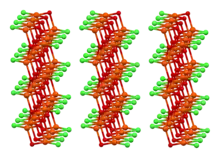 | |
| Names | |
|---|---|
| IUPAC name
Iron oxychloride | |
| Identifiers | |
3D model (JSmol) |
|
| ChemSpider | |
| ECHA InfoCard | 100.054.740 |
| EC Number |
|
PubChem CID |
|
CompTox Dashboard (EPA) |
|
| |
| |
| Properties | |
| ClFeO | |
| Molar mass | 107.29 g·mol−1 |
| Appearance | Vivid, dark violet, opaque crystals |
Except where otherwise noted, data are given for materials in their standard state (at 25 °C [77 °F], 100 kPa).
Infobox references | |
Iron oxychloride is the inorganic compound with the formula FeOCl. This purple solid adopts a layered structure, akin to that of cadmium chloride.[1] The material slowly hydrolyses in moist air. The solid intercalates electron donors such as tetrathiafulvalene and even pyridine to give mixed valence charge-transfer salts. Intercalation is accompanied by a marked increase in electrical conductivity and a color change to black.[2]
Production
FeOCl is prepared by heating iron(III) oxide with ferric chloride at 370 °C (698 °F) over the course of several days:[2]
- Fe2O3 + FeCl3 → 3 FeOCl
Alternatively, FeOCl may be prepared by the thermal decomposition of FeCl3⋅6H2O at 220 °C (428 °F) over the course of one hour:[3]
- FeCl3 ⋅ 6H2O → FeOCl + 5 H2O + 2 HCl
References
- ↑ Lind, M. D. (1970-08-15). "Refinement of the crystal structure of iron oxychloride". Acta Crystallographica Section B. 26 (8): 1058–1062. doi:10.1107/s0567740870003618.
- 1 2 Kikkawa, S.; Kanamaru, F.; Koizumi, M.; Rich, Suzanne M.; Jacobson, Allan (1984-01-01). Holt, Smith L. Jr. (ed.). Layered Intercalation Compounds. John Wiley & Sons. pp. 86–89. doi:10.1002/9780470132531.ch17. ISBN 9780470132531.
- ↑ Chen, C.; Yu, T.; Yang, M.; Zhao, X.; Shen, X. (2019). "An All-Solid-State Rechargeable Chloride Ion Battery". Advanced Science. 6: 1802130. doi:10.1002/advs.201802130. PMC 6425448.
This article is issued from Wikipedia. The text is licensed under Creative Commons - Attribution - Sharealike. Additional terms may apply for the media files.